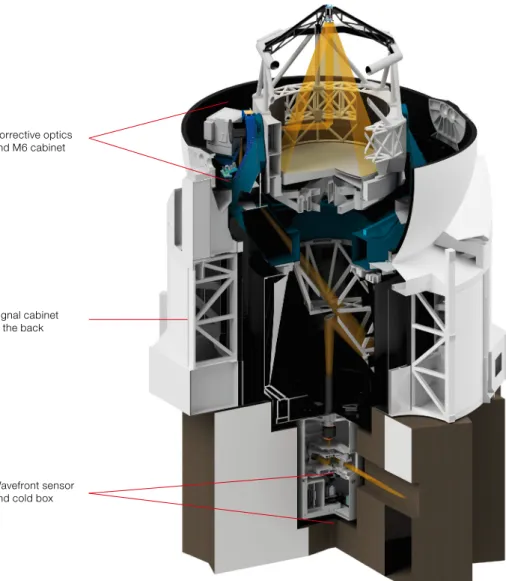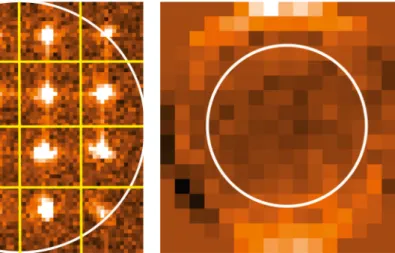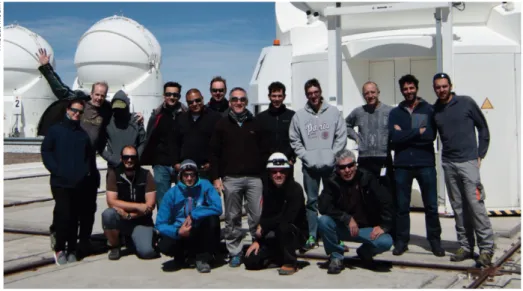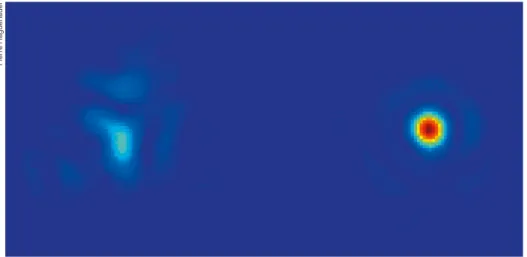HAL Id: hal-02413408
https://hal.archives-ouvertes.fr/hal-02413408
Submitted on 16 Dec 2019
HAL is a multi-disciplinary open access
archive for the deposit and dissemination of
sci-entific research documents, whether they are
pub-lished or not. The documents may come from
teaching and research institutions in France or
abroad, or from public or private research centers.
L’archive ouverte pluridisciplinaire HAL, est
destinée au dépôt et à la diffusion de documents
scientifiques de niveau recherche, publiés ou non,
émanant des établissements d’enseignement et de
recherche français ou étrangers, des laboratoires
publics ou privés.
Bringing the New Adaptive Optics Module for
Interferometry (NAOMI) into Operation
Frédéric Gonté, Jose Abad, Roberto Abuter, Emmanuel Carpentier, Jaime
Alonso, Luigi Andofalto, Pablo Barriga, Jean-Philippe Berger, Jean-Luc
Beuzit, Israel Blanchard, et al.
To cite this version:
Frédéric Gonté, Jose Abad, Roberto Abuter, Emmanuel Carpentier, Jaime Alonso, et al.. Bringing
the New Adaptive Optics Module for Interferometry (NAOMI) into Operation. 2019,
�10.18727/0722-6691/5149�. �hal-02413408�
Frédéric Gonté1
Jose Antonio Abad1
Roberto Abuter1
Emmanuel Aller Carpentier1
Jaime Alonso1 Luigi Andofalto1 Pablo Barriga1 Jean-Philippe Berger2 Jean-Luc Beuzit2 Israel Blanchard1 Henri Bonnet1 Guillaume Bourdarot2 Pierre Bourget1 Roland Brast1 Paul Bristow1 Luis Caniguante1 Susana Cerda1 Claudia Cid1 Alex Correa1 Eric Cottalorda2 Benjamin Courtney-Barrer1 Pascaline Darré1 Bernard Delabre1 Alain Delboulbé2 Roderick Dembet1 Ronald Donaldson1 Reinhold Dorn1 Jorge Dupeyron1 Christophe Dupuy1 Sebastian Egner1 Frank Eisenhauer5 Lorena Faundez1 Enrico Fedrigo1 Gerhard Fischer1 Christoph Frank1 Eloy Fuenteseca1 Philippe Gitton1 Thibaut Guerlet1 Sylvain Guieu2 Pablo Gutierrez1 Pierre Haguenauer1 Andreas Haimerl1 Xavier Haubois1 Cédric Heritier1 Stefan Huber1 Norbert Hubin1 Paul Jolley1 Laurent Jocou2 Jean-Paul Kirchbauer1 Johann Kolb1 Johan Kosmalski1 Peter Krempl3 Carlos La Fuente1 Jean-Baptiste Le Bouquin2 Miska Le Louarn1 Paul Lilley1 Bruno Lopez6 Marcelo Lopez1 Yves Magnard2 Enrico Marchetti1 Stewart Mclay1 Anthony Meilland6 Alexander Meister1 Antoine Mérand1 Thibaut Moulin2 Luca Pasquini1 Jérôme Paufique1 Isabelle Percheron1 Lorenzo Pettazzi1 Oliver Pfuhl5 Duc Phan1 Andres Pino1 Werther Pirani1 Jutta Quentin1 Andrew Rakich1 Andrés Ramirez1 Robert Ridings1 Mario Riedel1 Javier Reyes1 Sylvain Rochat2 Juan Sanchez1
Gonsalo Santos Tomás1
Christian Schmid1 Pavel Shchekaturov4 Nicolas Schuhler1 Matthias Seidel1 Christian Soenke1 Eric Stadler2 Christian Stephan1 Marcos Suárez1 Mirko Todorović1 Guillermo Valdes1 Cristophe Verinaud1 Julien Woillez1 Gérard Zins1 Sebastian Zúñiga-Fernández1, 7, 8 1 ESO
2 Institut de Planétologie et
d’Astrophy-sique de Grenoble (IPAG), Université Grenoble Alpes, CNRS, France
3 KRP Mechatec GmbH, Garching,
Germany
4 Pactum LTD, London, UK
5 Max Planck Institute for Extraterrestrial
Physics, Garching, Germany
6 Laboratoire Lagrange, Université Côte
d’Azur, Observatoire de la Côte d’Azur, CNRS, France
7 Universidad de Valparaíso, Instituto de
Física y Astronomía (IFA), Chile
8 Núcleo Milenio de Formación Planetaria
(NPF), Valparaíso, Chile
NAOMI was developed by a consortium composed of IPAG and ESO. Its Provi-sional Acceptance Chile review was held in April 2019. The NAOMI systems that have been installed on the Auxiliary Telescopes make the Very Large Tele-scope Interferometer (VLTI) and its instruments much less dependent on the atmospheric and dome seeing con-ditions. NAOMI increases the interfer-ometer’s operability and improves the performance of its instruments and, very early on, was identified as being critical to the VLTI. In this article, we review the project, describe its princi-ples and architecture, and offer a pre-view of the improvements it brings to VLTI instruments.
Context
Adaptive optics were considered for interferometric instruments even before non-interferometric instruments, as the measurement of high-quality interfer-ometric observables depends strongly on the wavefront quality. Therefore, the implementation of the adaptive optics (AO) systems on the Auxiliary and Unit Telescopes (ATs and UTs) of the VLTI has been recommended ever since the launch of the VLTI project (Beckers, 1990). Consequently, between 2003 and 2005 the UTs were equipped with the visible Multi-Application Curvature Adap-tive Optics systems (MACAO; Arsenault, 2003); later, in 2016, the UT AO coverage was extended into the infrared with the Coudé Infrared Adaptive Optics system (CIAO; Scheithauer, 2016).
The Auxiliary Telescopes
Although the design concept for the ATs developed by the Institut de Radioastro-nomie Millimétrique (IRAM; Von Der Lühe, 1997) included an AO system, this was omitted when construction started owing to a lack of resources, both in terms of personnel and funds. Instead, a tip/tilt corrector based on the System for Tip- tilt Removal with Avalanche Photodiodes (STRAP; Bonaccini, 1997) and a fast steering mirror was studied and imple-mented (Koehler, 2002, 2004). The ATs, depicted in Figure 1, each have a primary mirror of 1.8-metre diameter. They are
used by the VLTI for around 75% of the available nights.
NAOMI
NAOMI has completely replaced STRAP and is now the only wavefront correction system available on the ATs. It has three main components that are fully embed-ded in the telescopes: a wavefront sen-sor; a deformable mirror; and a real-time computer. The wavefront sensor was developed at ESO headquarters; it is a Shack–Hartmann Sensor sensitive to visi-ble wavelengths with a 4 × 4 lenslet array, of which 12 sub-apertures are used. The low number of sub-pupils was driven by the requirement to maintain a high sensi-tivity for the VLTI-AT array. The detector is an off the shelf EM-CCD camera iXon ultra 897 developed by ANDOR (UK). The wavefront sensor is also integrated on a field-tracking stage to pick up the correct field. A neutral density filter wheel has been integrated just above the wavefront sensor to adjust the illumination in case of high flux, and a notch filter has been integrated into the wavefront sensor optics to reject any contamination from the lasers of the Adaptive Optics Facility (AOF; Arsenault, 2017) implemented on UT4. The full wavefront sensor and its fil-ter wheel are installed in the lower part of the Relay Optics Structure. It receives the visible part of the light after the M9 dichroic mirror which redirects the infra-red component to the VLTI instruments. The corrective optics (Le Bouquin, 2018), developed by IPAG, consist of a deforma-ble mirror (DM241), which has 17 actua-tors across its clear aperture, produced by ALPAO France, and which is integrated in a motorised gimbal mount. It is installed at the M6 pupil location in the coudé train. In addition to compensating for atmos-pheric turbulence, it provides the chop-ping capability required by MATISSE. The DM241 has a clear aperture of 37.5 mm, but NAOMI uses only the central part over a 28-mm (11-actuator) diameter pupil as seen in Figure 2 (right).
The deformable mirrors were character-ised at room temperature at IPAG and then in a thermal chamber between 5 and 20 degrees C at ESO headquarters. The outcome convinced the project team that
a temperature-controlled calibration bench was necessary at Paranal. IPAG finalised this bench, which is now used as a maintenance tool on Paranal. We discovered on Paranal that the deforma-ble mirror had a more complex thermal dependence than previously understood and that the mirror displayed unpredicta-ble behaviour. It is therefore necessary to calibrate the deformable mirror on sky at each target acquisition. The result of the characterisation of the mirrors was presented at the Adaptive Optics for Extremely Large Telescopes (AO4ELT) conference in June 20191 (see
Haguenauer, 2019).
The real-time computing unit is based on the ESO-standard SPARTA Light platform (Suárez Valles, 2012) and has been cus-tomised by PACTUM Ltd for the NAOMI
project. It uses the same platform as for the CIAO of the UTs, which facilitated its development in Garching and simplifies the operation on Paranal. The hardware is implemented in the electronics rack of the signal cabinet (see Figure 1). This unit makes the acquisition on the Shack– Hartmann Sensor, analyses the wavefront aberration and the pupil derotation to be corrected, calculates the correction to be applied to the deformable mirror and then sends the command to the mir-ror. Since the deformable mirror and the Telescopes and Instrumentation Gonté F. et al., Bringing NAOMI into Operation
Corrective optics and M6 cabinet
Signal cabinet in the back
Wavefront sensor and cold box
Figure 1. 3D cross-sectional view of an AT showing the locations of the NAOMI components. The correc-tive optics and its electronics are implemented at the level of the azimuth; the wavefront sensor and its electronics are implemented in the lower part of the Relay Optics Structure. The real-time computer and the remaining control electronics are implemented in the signal cabinet.
P et er K re m pl
ANDOR camera are commercial prod-ucts, interfaces between SPARTA light and these components had to be devel-oped. The real-time computer measures 24 gradients on the wavefront sensor at a frequency up to 500 Hz and corrects up to 14 modes on the deformable mirror depending of the brightness of the star. Manufacturing, Assembly, Integration and Testing (MAIT)
The MAIT phase began in January 2017 with several activities in parallel. IPAG worked on the deformable mirror charac-terisation, the corrective optics integra-tion and its dedicated electronics while ESO worked on the wavefront sensor, the electronics, the real-time computer, the software and the test bench. The integration and alignment of the NAOMI test bench were carried out by members of the ESO Mechanical Engineering and Optical Engineering Departments. The goal was to replicate as accurately as possible the behaviour of an on-sky target in the laboratory as it would be observed by an AT at Paranal. The bench consisted of an optical table and a replica of the Relay Optics Structure used by the AT. The optical table facilitated simulation of sky and AT behaviour. An artificial on-sky target was created via a monomode fibre connected to a halogen lamp. A pupil mask was used to define the spider of the AT (the spider is the strut that sup-ports the mirror) while the deformable mirror itself simulated the atmospheric turbulence thanks to its high density
of actuators. IPAG provided phase maps for different levels of turbulence which were run in parallel to the applied correc-tion by the AO loop. This approach was much more flexible and more useful than using a turbulence generator with phase plates. Finally, a derotator integrated into the Relay Optics Structure was used to create the pupil rotation on the wave-front sensor to be fully representative of the Paranal conditions. An infrared cam-era was integrated into the bench to record the resulting star-like image. This same camera was later re-used during the Assembly, Integration and Verification (AIV) phase for the stand-alone charac-terisation of NAOMI on sky.
The NAOMI software is fully embedded in the AT software. It was developed in the control model implemented at ESO headquarters before being tested on the NAOMI test bench. The ESO software department obtained two years of exter-nal support from CNRS in order to ensure
testing before its integration onto the test bench and was delivered by PACTUM Ltd. A prototype of the wavefront sensor was first developed to validate the opto- mechanical concept as well as the inte-gration and alignment procedure. The required mechanical improvement to the design was then made by KRP Mechatec GmbH who also provided the tooling required for the MAIT and the AIV. The electronics development and integration were supported by the electronics groups at ESO in order to account for the evolu-tion of the ATs and to conduct a thorough analysis of the cabling and interface. The system test began in November 2017, led by the system engineer and the AO engineer while other team mem-bers produced and tested the final ver-sions of the electronics, wavefront sen-sors and corrective optics. In addition to the NAOMI test bench, the project team developed dedicated test benches for the electronics, the wavefront sensor and the corrective optics. This allowed the
Figure 3. NAOMI test bench in integration. The corrective optics are seen at the top right.
E m m an uel A ller C arp en tier
different aspects of the implementation. The first team took care of the cooling and cabling upgrade of the Relay Optics Structure and the implementation of the NAOMI components. The second worked on the replacement and upgrade of the electronics cabinets while the third focussed on the internal re-alignment of the ATs with the corrective optics (Fig-ure 5). With so many activities in parallel, regular reorganisation and reassignment of tasks was necessary, requiring the staff to be flexible.
The assembly and integration part of the AIV proceeded faster than planned, and on 18 September the first AT was ready for the first stand-alone verification on sky, during which the functionalities and AO performance could be evaluated (see Figure 6). Soon after, two telescopes were available for verification working together with the VLTI. It was impressive to see the NAOMI team simultaneously in the New Integration Hall, in the AT Ser-vice station, in the VLTI building, and in the Control Room working hard toward getting the first closed-loop with NAOMI. The AIV included 32 missions from Europe, with an average of nine project members working at Paranal over a two-month period.
required for AIV. The NAOMI AIV was the first time that a system was imple-mented simultaneously on four tele-scopes at Paranal. To mitigate the risks, the main procedures were fully rehearsed before the start of AIV. The plan also included adequate contingency in the schedule, and redundancies in the staff competences.
AIV began on 6 September 2018, follow-ing a few days of preparation durfollow-ing which the four Relay Optics Structures were removed and transported to the New Integration Hall and the first AT was moved to the service station to allow the removal of the fast steering mirror and the implementation of the corrective optics.
Many activities were then carried out in parallel, with three teams focusing on verification of all of the components to be
delivered to Paranal independently of the main NAOMI test bench, which was fully dedicated to the NAOMI functional and system test.
In parallel with the systems test, the AIV team and several engineers from Paranal were trained on the test bench every time a corrective optics or a wavefront sensor needed to be exchanged to ensure a high level of confidence in the procedures. Provisional Acceptance Europe, held in July 2018, concluded these system tests. Assembly, Integration and Verification AIV was prepared well before the arrival of the NAOMI equipment on Paranal. Several missions to Chile were necessary to verify the ATs, check the interfaces, and ensure the feasibility of the AIV plan via discussions with Paranal staff. The plan accounted for various factors, including the availability of tools such as the crane, the staff, the locations where various activities had to be performed, and the logistics of accommodating the 14-member project team at the Residencia.
It became apparent that science opera-tions of the VLTI with ATs would have to be suspended during AIV of NAOMI; which necessitated minimising the time
Telescopes and Instrumentation Gonté F. et al., Bringing NAOMI into Operation
Figure 4. Some of the members of the NAOMI pro-ject team during AIV; first row, from left to right: Thibaut Guerlet, Christian Soenke, Sylvain Rochat, Luis Caniguante; second row, left to right: Pascaline Darré, Pabio Gutierrez, Emmanuel Aller Carpentier, Frederic Gonté, Roderick Dembet, Stefan Huber, Alain Delboulbé, Peter Krempl, Laurent Jocou, Pierre Bourget, Sylvain Guieu, Thibaut Moulin.
Figure 5. Intervention at the beginning of the night on the corrective optics of AT4 conducted by Pascaline Darré and Sylvain Guieu.
T hib au t M ouli n Juli en W o ill ez
Commissioning
The NAOMI project had two commis-sioning periods led by IPAG and sup-ported by ESO; these involved 14 mis-sions. During this time NAOMI was also commissioned on the current instrument suite at VLTI: GRAVITY (GRAVITY Collab-oration et al., 2017), the Multi AperTure mid-Infrared SpectroScopic Experiment (MATISSE; Lopez, 2014) and the Preci-sion Integrated Optics Near Infrared ExpeRiment (PIONIER; Zins, 2011). Com-missioning began with the first light of NAOMI using the four ATs and GRAVITY on 20 October. It was dedicated to verify-ing functionality with the VLTI and ensur-ing stable operation. In order to measure how NAOMI improved the performance of the PIONIER and GRAVITY instruments, several indicators were monitored, includ-ing throughput, flux drop-out estimators and fringe tracking residuals. All meas-urements were compared against tip/tilt-only correction. The chopping capability was functionally tested with MATISSE. The reliability of the NAOMI system was analysed and found slightly non-compliant owing to a few issues that had a minor impact on operation. At the end of the first commissioning on 17 November the ATs were transferred back into science operation.
The ESO team with the support of IPAG continued to follow the performance
Figure 6. Acquisition of a star with the infrared Strehl camera (H-band) in open loop (left) and in closed loop (right) for quasi-instantaneous Strehl measure-ment (50 ms integration time) during the stand-alone verification of AT1.
of NAOMI closely during these opera-tions. The team made extensive use of the Garching Remote Access Facility before the second commissioning, in order to solve issues discovered by the Paranal operation team.
The second commissioning period, which began on 25 February 2019, focused on the VLTI instrument performance gains resulting from NAOMI, in particular the improvement for faint stars, with lower than average seeing and the AT dome seeing effect. NAOMI greatly improves the injection flux in the spatial filters and/or the fibres of the interfero-metric instruments. It improves the signal to noise of each instrument and signifi-cantly reduces the loss of fringes on the Gravity Fringe Tracker. NAOMI is much more robust to atmospheric conditions than STRAP. It corrects the dome seeing observed with low wind conditions and corrects the atmospheric seeing well above 1.4 arcseconds. The performances of VLTI instruments with NAOMI are detailed in Woillez et al. (2019). Operations
NAOMI is now fully integrated in the oper-ation of the VLTI. A typical observing night always follows the same procedure: two hours before sunset, the VLTI start- up procedure is launched, the functionali-ties of each subsystem are automatically verified, and the optical path is validated up to the InfraRed Imaging Sensor (IRIS; Gitton, 2004) in the VLTI Laboratory — allowing the verification of the alignment of the pupil and of the field. After twilight,
of view in the closed loop is 2.25 arc-seconds. The full process between the launch of the preset and the closed loop is automatic, requiring approximately 140 seconds. A manual procedure can be used for very specific targets, such as a close binary. At the end of the night, the NAOMI system is automatically re-checked while the ATs are being closed and set in standby mode for the day. The day team then checks the calibration data and applies any correc-tions that may be needed before the next VLTI start up.
All the telescopes used by the VLTI are now in operation with adaptive optics systems as recommended by Pierre Léna (Léna, 1987) and Jacques Maurice Beckers (Beckers, 1990); we remain indebted to them for their vision. References
Arsenault, R. et al. 2003, The Messenger, 112, 7 Arsenault, R. et al. 2017, The Messenger, 168, 8 Beckers, J. M. et al. 1990, The Messenger, 60, 1 Bonaccini, D. et al. 1997, Proc. SPIE, 3126, 77 Gitton, P. et al. 2004, Proc. SPIE, 5491, 944 Gravity Collaboration 2017, The Messenger, 170, 10 Haguenauer, P. & Guieu, S. 2019, Proc. AO4ELT conference, in press
Koehler, B. et al. 2004, The Messenger, 115, 15 Koehler, B. et al. 2002, The Messenger, 110, 21 Le Bouquin, J. B. et al. 2018, Proc. SPIE, 1070371 Léna, P. 1987, The Messenger, 50, 53
Lopez, B. et al. 2014, The Messenger, 157, 5 Scheithauer, S. et al. 2016, Proc. SPIE, 9909, 99092L
Suárez Valles, M. 2012, Proc. SPIE, 8447, 84472Q Woillez, J. et al. 2015, The Messenger, 162, 18 Woillez, J. et al. 2019, A&A, 629, A41 Zins, G. et al. 2011, The Messenger, 146, 12
Links
1 Adaptive Optics for Extremely Large Telescopes
Conference (A04ELT) held in Québec City, Canada in June 2019: http://ao4elt6.copl.ulaval.ca/



